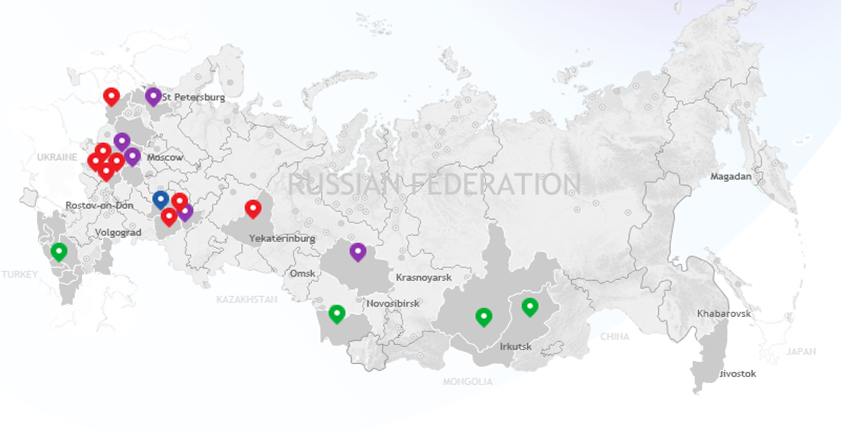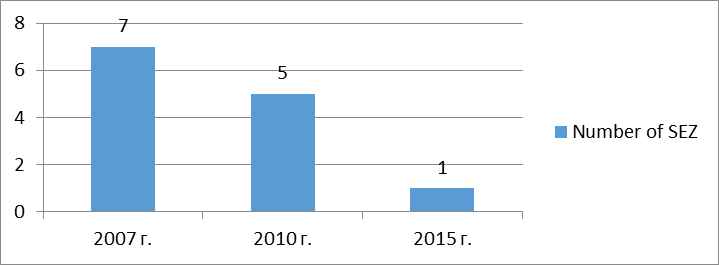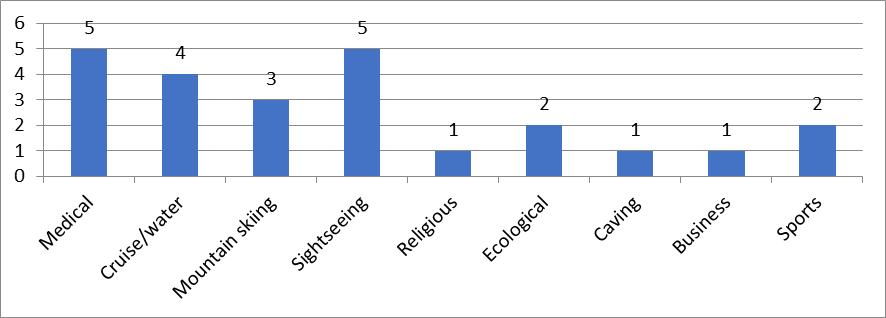Abstract
Current trends in the development of mesoeconomic processes dictate the need to use various mechanisms to attract domestic and overseas funding to the regions. In world practice, special economic zones are often established to stimulate various processes at a territorial level, i.e. to create new job places, improve social and economic as well as demographic situation, optimize regional budget, enhance the region’s image both at the Russian and international levels, and increase the level of import substitution. The establishment of such zones is of strategic importance for the state economy. Special economic zones are created to develop separate economic areas, i.e. logistics, engineering, innovation, tourism and others. The article describes the implementation of special economic zones in the regions of the Russian Federation. In 2019, their number amounted to twenty-one in various regions of Russia. By territorial distribution, the most concentration is observed in the European part of the country. The economic performance of zones is based on the establishment of joint-stock companies. Management is carried out by AO Special Economic Zones (RosOEZ). The genesis of the composition and structure is considered in detail; the reasons for their status change are analyzed. The article explores advantages that enterprises receive in special economic zones, as well as opportunities for their development. The article exposes the issues faced by the enterprises in the field of tourism industry. In conclusion, the on the establishment of tourism and recreation special economic zone in the Arctic zone of the Russian Federation recommendations are made.
Keywords: Special economic zonestourismrecreation zones
Introduction
In world practice, for the purpose of development of regional economy, the establishment of special zones offering preferential conditions for their residents, that is, companies registered in this territory, for example, offshores, territories of advanced social and economic development, free trade zones and others is quite effectively applied. Countries like China (Yuan, 2017) and India (Mukherjee, 2016) are actively using incentives for individual regions to advance at the state level, given the growing influence of the countries on the world economic processes. Naturally, the performance of these zones depends on the level of development of the state (Neucheva, 2017).
State support aimed to increase the performance of regional economy can have both positive and negative effects.
The study of the problems of establishment and development of such territories was done by such overseas and domestic scientists as Yuan Y., Dr. Seema P. Joshi, Narkhede P.A., Sindhu J., Sobirov B., Latkin A.P., Stetsko N.I., Grishin S.Yu., and many others.
The idea of region development and its specialization is under the jurisdiction of federal authorities, which leads to a lack of clear understanding of its unique features.
A special place in the development of many countries is taken by tourism industry, for example, in Egypt, Croatia, Thailand, the country’s budget is directly dependent on inbound tourism. Tourism is an industry that forms an idea of the region in the eyes of the world community and domestic tourists. With the help of the tourist services the service level is spread in the region and in the country. Therefore, tourism and recreation special economic zones should receive active support and advancement from all levels of government.
Problem Statement
There are various approaches to the development of territorial entities in the form of special economic zones. One way is investment in free zones; that is, specific areas of a country in which trade tariffs are normal, rationing is eliminated, and bureaucracy that hinders attraction of new business and foreign capital is diminished (Akbari, Azbari, & Chaijani, 2018).
Another way of development is the establishment of an import substitution mechanism in special economic zones, without access of foreign capital to them. Caraballo-Cueto (2016) notes the following:
However, there are still several ways to incentivize local producers, but the government needs to be more creative. Some channels are controlling energy costs, providing more technology and increasing the difficulties to import, among others. The incentives to infant industries should be conditional on growth achievements by these firms rather than creating a permanent protection for these companies, which is the unfortunate side to the imports substitution program. (p. 182)
One cannot help arguing that measures taken to support import substitution by establishing special economic zones do not make sense if enterprises located in these zones are not competitive globally. The Russian practice of developing territories with special economic status is quite extensive. The Russian Federation is a member of the Customs Union, as well as a party to bilateral agreements with all countries of the Commonwealth of Independent States (CIS).
Nevertheless, there are several problems which the creators of special economic zones in the Russian Federation faced with, among them are the following: insufficient number of residents, short period of granting benefits, etc. It is necessary to analyze in a more detailed way the current state of tourism and recreation zones in order to understand if there is a need to continue to apply the mechanism of regional development.
Research Questions
The subject of the study is the mechanism of increasing the efficiency of social and economic situation of a region through the establishment of tourism and recreation special economic zones.
Purpose of the Study
The purpose of the article is to study the current state and opportunities for the development of tourism and recreation special economic zones in the Russian Federation. To achieve this goal, the following tasks were set: studying and analyzing sources of the topic under study, determining the composition and structure of tourism and recreation special economic zones, identifying the dynamics of changes in their number, determining the reasons for these changes, developing recommendations for improving the efficiency of such mechanism as special tourism and recreation economic zones.
Research Methods
The methods of statistical and logical analysis, as well as the graphical method were used in this study.
Findings
Different types of special economic zones include offshores, an example of which in the Russian Federation may be the special administrative regions (SAR) created in 2018 on the October Island in Kaliningrad and Russian Island in Primorye. At the end of 2018, 9 foreign companies applied for registration as residents of SAR. In case of success, the companies receive the following benefits: full exemption from income tax in the form of dividends, tax on profits from sale of shares of foreign companies. There are special regimes of currency regulation and 5% tax on income received by foreign entities in the form of dividends on shares of the international holding companies on the territory of such areas (Pyatrauskaite, 2019).
The offshore zone in the Kaliningrad Region was created even despite the fact that its investment risk as a region with an industrial SEZ (Ivanov et al., 2015) was assessed as moderate and its potential as low.
In July 2005, the Federal Law No. 116-FZ “On Special Economic Zones in the Russian Federation” was adopted, which focused on the development of territories where enterprises would be supported in promising areas, i.e. manufacturing, high-tech industries focused on research, tourism and recreation, logistics, development of new types of products and technologies.
According to the aforementioned federal law, special economic zones are territories endowed with special legal status and economic (tax, customs, infrastructure) benefits for Russian and foreign investors operating in the priority sectors for Russia.
Let us consider in more detail tourism and recreation special economic zones (TR SEZ), which were created for the development of tourist clusters in the Russian Federation (Kuchumov, Zigern-Korn, Testina, & Boykova, 2018).
Figure
The basis of TR SEZ is tourist clusters and territorial and spatial complexes (Zyryanov & Myshlyavtseva, 2012). In the authors’ opinion, special economic zones are based on tourist clusters; however, they are not identical.

The tourist clusters are a temporary interaction of enterprises, spatially subordinate and competing in the same market and united by the tourist flow (Zyryanov & Myshlyavtseva, 2012). Based on the analysis of definitions of tourist clusters (Kozlov, 2016), it can be concluded that the cluster approach in the context of tourist and recreational areas includes a set of geographically neighboring and interacting companies, which include educational institutions, government agencies , creating and directing tourist flows, using the tourist and recreational potential of the territory.
The purpose of creating tourism and recreation special economic zones is the support of tourism industry enterprises in the chosen field provided by state, which is as follows:
- preferential taxation and exemption from payment of certain taxes, for example, property tax, transport tax;
- preferential rent;
- possibility of land redemption;
- reduced insurance premium rates.
The possibility of reducing up to 30% of the cost of implementing business projects in comparison with the territories that do not have the status of a special economic zone (Baskhanova, 2018) is noted.
Figure
According to Figure

Figure

The tourism and recreation special economic zones were established in the period from 2007 to 2015. Most zones, i.e. 7 of them were created in February 2007. Only three zones could be operated by the end of 2018 out of those established in 2007, among them are: Baikal Harbor, Gate-Baikal, and also Turquoise Katun. Such zones as the Valley of Altai, New Anapa, Grand Spa Yutsa, Curonian Spit were liquidated in 2016.
In 2010, 5 TR SEZs were created: North Caucasian tourist cluster Resorts of the North Caucasus (Republic of Dagestan (Derbent, Karabudakhkent, Kayakent, Magaramkent, Khunzakh MR), Karachay-Cherkess Republic (Zelenchuksky, Urupsky MR), Kabardino-Balkaria Republic (Chereksky, Zegrom, Zegushsky, Ugra) Republic of Ingushetia (Dzheirahsky, Sunzhensky MR), Chechen Republic (Itum-Kaleinsky MR), TR SEZ North Caucasian tourist cluster Lagonaki, TR SEZ North Caucasian tourist cluster Republic of North Ossetia-Alania (Alagirsky, Irafsky MR), TR SEZ North Caucasian tourist cluster Republic of Adygea (Maikopsky MR), TR SEZ Russian Island.
Out of the zones opened in 2010, the North Caucasus tourism cluster Resorts of the North Caucasus is in operation, which in 2016 was joined by the remaining zones of the North Caucasus tourism cluster, thus, it was not the lequidation, but the consolidation of the cluster. In Primorsky Krai the TR SEZ Russian Island ceased to exist.
In 2015, the TR SEZ Zavidovo in the Tver Region was opened, which is currently in force.
Figure shows the reasons for TR SEZ liquidation.
According to the media (Chalova, 2016), on the basis of which Figure

These reasons served to terminate the work of such zones as: TR SEZ North Caucasian tourist cluster Republic of Adygea, TR SEZ North Caucasian tourist cluster Republic of North Ossetia-Alania, TR SEZ New Anapa, TR SEZ North Korean tourist cluster Lagonaki, TR SEZ Russian Island, TR SEZ Grand Spa Yutsa, TR SEZ Curonian Spit.
There were also problems in the TR SEZ Russian Island associated with free transfer of land plots from the Ministry of Defense of the Russian Federation and federal property to the Primorsky Territory.
The only SEZ, the liquidation of which was due to the technical reason, was the TR SEZ Dolina Altai (Altai Republic). The general contractor (Novosibirsk Sibmost) was unable to cope with the flowing artificial lake. The zone has never been opened, despite investing 2.5 billion rubles in the construction of this lake.
The liquidation of most of the created SEZs indicates the wrong choice of incentives for entrepreneurs who did not see any opportunities for themselves in a slight decrease in the tax burden, while they had to be constantly accountable to state authorities, as well as various commissions. Such enterprises are under constant control of media, which leads not to the quality focusing of the services provided, but to the desire to fulfill socially important tasks.
In addition, it turned out that 24 billion rubles allocated for the development of SEZ have not been mastered and are kept on deposit. On average 10.2 million rubles was spent on creating one workplace in SEZ (Filatova & Chumakova, 2017).
Figure

According to Figure
The geographical position of SEZs and their residents undoubtedly influence the types of tourism offered in the clusters. Figure

According to Figure
The cruising/water tourism is actively developing. 4 of the SEZs, in addition to Zavidovo can offer tourists the opportunity to use water transport for entertainment purposes.
Three SEZs have the capabilities of ski resorts, especially the Resorts of the North Caucasus, which incorporated at least 6 ski resorts.
The ecotourism is not widely spread. It is established only in the TR SEZ North Caucasus tourist cluster Resorts of the North Caucasus and the TR SEZs Biryuzovaya Katun.
It should be noted that the TR SEZs currently operating will soon stop receiving benefits on the insurance premiums; many enterprises no longer receive benefits on other taxes and fees as well. This may be the reason for reducing the number of residents of special economic zones and the zones themselves.
The development of the arctic part of the Russian Federation is thought to be a promising area for development of tourism and recreation special economic zones. There have been held many meetings at different levels, which argue the need for diversification of the Arctic zone. Currently, the main activity in this area is logistics (port) and industrial tourism; however, the flow of tourists to Murmansk and the Murmansk region, as regions of the North-West Federal District (Pecheritsa, 2017), as well as to the Siberian Federal District (Pecheritsa, Kuchumov, & Testina, 2018) is regularly increasing, which provides an opportunity for the development of tourism in these regions based on such federal programs as the ‘Strategy for Development of the Arctic Zone of the Russian Federation and Ensuring National Security until 2020’ and the ‘Development of Domestic and Inbound Tourism in the Russian Federation (2019 - 2025 years)’.
Conclusion
The consistent measures are being taken to develop the tourism industry in the Russian Federation, which has the potential to solve not only economic, social, political, environmental problems of the regions, but also enhances the country’s image at the international level.
Despite huge tourist potential, natural resources and objects of national cultural heritage represented in Russia there is a problem of shortage of accommodation facilities, poorly developed tourist infrastructure as well as the service quality.
State support by the region is expressed in the creation of special economic zones, which should increase the number of residents in the regions, create conditions for high competition, create jobs in the industry and differentiate tourist flows.
Creating tourism and recreation special economic zone will create better conditions for the development of transport and utilities infrastructure, develop new tourist routes, and also improve tourist service quality. The development of special economic zones in the Arctic will attract attention of not only foreign, but also Russian tourists to this region.
References
- Akbari, M., Azbari, M. E., & Chaijani, M. H. (2018). Performance of the Firms in a Free-Trade Zone: The Role of Institutional Factors and Resources. European Management Review.
- Baskhanova, S. (2018). Investment in the Caucasus. Retrieved from: http://vesti95.ru/2018/10/investiruj-v-kavkaz-3/
- Caraballo-Cueto, J. (2016). Free trade zones, liberalization, remittances, and tourism, for what?: Jobless growth in the Dominican Republic. International Journal of Development, 15, 181–200.
- Chalova, E. (2016). No to “sawing”: why do they lequidate special economic zones. Retrieved from: https://riafan.ru/528581-net-raspilam-pochemu-zakryvayut-osobye-ekonomicheskie-zony
- Filatova, S. E., & Chumakova, M. V. (2017). International Free Trade Zones with Participation of Russia. Retrieved from: https://moluch.ru/archive/139/39076/
- Ivanov, V. N., Gorokhov, A. Yu., Gorokhov, D. A., Ignatiev, A. Yu., Smirnov, V. G., & Tuchinsky, A. L. (2015). Special economic zone in Kaliningrad Region: competitiveness of economic regime and development of exclave region of Russia. Economics, 127, 98–108.
- Kozlov, M. A. (2016). Tourist and recreation cluster: concept and basic theoretical and methodological characteristics. Strategy for Sustainable Development of Russian Regions, 32, 150–159.
- Kuchumov, A. V., Zigern-Korn, N. V., Testina, Ya. S, & Boykova, Yu. M. (2018). Development Trends of Tourism Clusters in the Russian Federation. Retrieved from: https://iopscience.iop.org/article/ 10.1088/1755-1315/204/1/012021/pdf
- Mukherjee, A. (2016). Special Economic Zones in India: Status, Issues and Potential. New Delhi, Springer India, Imprint: Springer.
- Neucheva, M. Yu. (2017). Functioning of special economic zones in various social and economic systems. Problems of the modern economy, 2(38), 249.
- Pecheritsa, E. V. (2017). Problems and prospects of tourism clusters in the regions of the Northwestern Federal district. Servis Plus, 4, 22–32.
- Pecheritsa, E. V., Kuchumov, A. V., & Testina, Ya. S. (2018). Some of Determinants of the Sustainability of Tourism in Siberian Federal District. Retrieved from: https://iopscience.iop.org/article/10.1088/ 1755-1315/204/1/012036/meta
- Pyatrauskaite, A. (2019). Development Corporation officially manages the Kaliningrad offshore. Retrieved from: https://kaliningrad.rbc.ru/kaliningrad/21/01/2019/5c45793a9a794790d5cc48fb.
- Yuan, Y. (2017). Studies on China's Special Economic Zones, Singapore, Springer Singapore, Imprint: Springer.
- Zyryanov, A. I., & Myshlyavtseva, S. E. (2012). Tourist clusters and dominants (example of Perm Territory). News of the Russian Academy of Sciences. Geographical series, 2, 13–20.
Copyright information

This work is licensed under a Creative Commons Attribution-NonCommercial-NoDerivatives 4.0 International License.
About this article
Publication Date
28 December 2019
Article Doi
eBook ISBN
978-1-80296-075-4
Publisher
Future Academy
Volume
76
Print ISBN (optional)
-
Edition Number
1st Edition
Pages
1-3763
Subjects
Sociolinguistics, linguistics, semantics, discourse analysis, science, technology, society
Cite this article as:
Testina, Y., Voloshinova, M., Karpova, G., & Kuchumov*, A. (2019). Challenges And Opportunities Of Development Of Tourism And Recreation Special Economic Zones. In D. Karim-Sultanovich Bataev, S. Aidievich Gapurov, A. Dogievich Osmaev, V. Khumaidovich Akaev, L. Musaevna Idigova, M. Rukmanovich Ovhadov, A. Ruslanovich Salgiriev, & M. Muslamovna Betilmerzaeva (Eds.), Social and Cultural Transformations in the Context of Modern Globalism, vol 76. European Proceedings of Social and Behavioural Sciences (pp. 1848-1856). Future Academy. https://doi.org/10.15405/epsbs.2019.12.04.248
